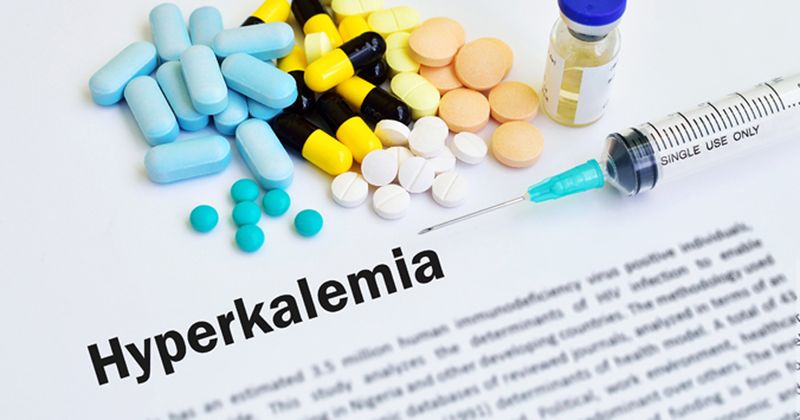Patiromer enables optimal medical therapy, prevention of hyperkalemia in HFrEF
WASHINGTON — Patiromer, a novel potassium binder, was associated with a reduction in hyperkalemia in patients with HF with reduced ejection fraction, enabling an increase in adherence to optimal medical therapy, researchers reported.

“One of the reasons why guideline-directed medical therapy is tough to achieve for renin-angiotensin-aldosterone system inhibitors, all of which are therapies associated with improvement in mortality and morbidity for patients with HFrEF, is the risk of hyperkalemia, which tends to be higher in older patients or those with comorbidities such as diabetes and chronic kidney disease,” Cardiology Today Editorial Board Member Javed Butler, MD, MPH, MBA, FACC, FAHA, FESC, president of the Baylor Scott and White Research Institute, senior vice president for Baylor Scott and White Health and distinguished professor of medicine at the University of Mississippi, said during a press conference at the American College of Cardiology Scientific Session. “The question is, we do have these novel potassium binders that are well tolerated, so can we give them to optimize medical therapies for our patients with HFrEF.”

Patiromer (Vifor Pharma) has been shown to help prevent hyperkalemia and maintain normokalemia, but its experience in patients with HFrEF is limited. The DIAMOND trial was designed to determine if the drug could control potassium levels and enable optimal RAAS inhibitor therapy, Butler said.
The trial included 878 patients (mean age, 67 years; 27% women) with NYHA class II to IV HF and EF < 40% who were on beta-blockers or unable to tolerate them and had past or present hyperkalemia (> 5 mEq/L). If a patient had past hyperkalemia, it had led to the discontinuation or reduced dosage of at least one RAAS inhibitor, Butler said.
The original primary endpoint was time to CV death or first CV hospitalization, but that was changed during the COVID-19 pandemic due to concerns about enrollment, drug supply and other factors, Butler said during a presentation. The revised primary endpoint was adjusted mean change in serum potassium to the end of the study on June 24, 2021.
Among the cohort, 360 patients from the patiromer group and 367 patients from the placebo group completed the blinded study treatment, Butler said.
Change in serum potassium levels between baseline and the end of the study was lower in the patiromer group than in the placebo group (patiromer, 0.03 mEq/L; 95% CI, –0.01 to 0.07; placebo, 0.13 mEq/L; 95% CI, 0.09-0.16; difference, –0.1; 95% CI, –0.13 to –0.07; P < .001), Butler said.
The rate of hyperkalemia of > 5.5 mEq/L was lower in the patiromer group than the placebo group (patiromer, 13.9%; placebo, 19.4%; HR = 0.63; 95% CI, 0.45-0.87; P = .006), according to the researchers.
The endpoint of reduction of mineralocorticoid receptor antagonist dose below target also occurred less often in the patiromer group than in the placebo group (patiromer, 13.9%; placebo, 18.9%; HR = 0.62; 95% CI, 0.45-0.87; P = .006), Butler said.
Total number of investigator-reported hyperkalemia events was 225 (77.7 per 100 person-years) in the patiromer group and 316 (118.2 per 100 person-years) in the placebo group (HR = 0.66; 95% CI, 0.53-0.81; P < .001), the researchers found.
The researchers also calculated win ratios for hyperkalemia-related outcomes and RAAS inhibitor use score, and both favored patiromer (win ratio for hyperkalemia = 1.53; 95% CI, 1.23-1.91; P < .001; win ratio for RAAS inhibitor use score = 1.25; 95% CI, 1.003-1.564; P = .048).
The results for the primary endpoint were consistent across prespecified subgroups except for region, Butler said. Compared with patients from the rest of the world, patients from Eastern Europe had less of a difference between the patiromer and placebo groups in the primary endpoint (P for interaction = .022), but the difference between patiromer and placebo remained significant in Eastern Europe, he said.
Serious adverse events occurred in 12.3% of the patiromer group and 13.2% in the placebo group, while 2.7% of the patiromer group and 2.5% of the placebo group had adverse events leading to withdrawal, Butler said.
“We did not have enough clinical events because the trial was stopped early to make any conclusive comments about clinical outcomes, but it stands to reason that optimization of RAAS inhibitor therapy without the concomitant risk of hyperkalemia may in the long run lead to better outcomes for these patients,” Butler said at the press conference.


